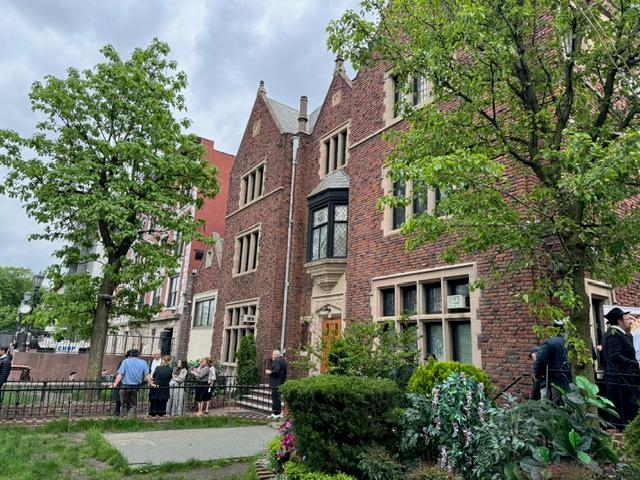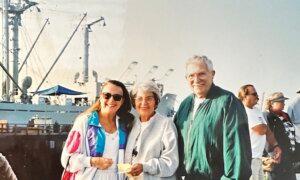I’m no expert in boiler rooms. I can’t remember the last time I was in one. These days they seem to be a thing of the past, the once ubiquitous oil trucks superseded by modern means of heating.
But I do remember the one in my Manhattan building when I was around eight. It was a dank and musty place in the basement I would sneak through on my way to play stickball with the superintendent’s son in the courtyard. The neighbors didn’t like the noise.
The rabbi also was smiling when he made that characterization, but I could see he was serious, and there is a good argument he was right—and not just because the room in which we were sitting indeed resembled a boiler room at least in its austerity, though much bigger than any I could remember. One could say it was deliberately down market, yet people had come from all over the world for the event to sit on hard wooden chairs and benches. (There was, however, an incentive: plenty to eat, a well-known Jewish tradition. Also, other rooms were less austere. In fact, some were opulent.)
I was there because of a journey I have been on of a spiritual nature that is also a search for my roots.
A Different Education
The group organizing the gathering—the Jewish Learning Institute (JLI) of the same Hasidic movement—I discovered had become the biggest purveyor of Jewish education in the world. I was not entirely surprised because my wife and I had been taking their excellent courses from Rabbi Yitzchok Tiechtel of Chabad of Nashville. We both had been Ivy Leaguers years ago, in better times for those schools, but now we were engaged in study that was in many ways deeper and more personally fulfilling.One course was an introduction to Kabbalah—a subject too complex to discuss here (and at which I am only a beginner), but both of us were intrigued by the startling similarity between the Kabbalistic view of creation and aspects of particle physics and cosmology. It was the most satisfying explanation of creation either of us had heard before and worthy of much further study.
The other course had the seemingly more mundane title “Advice for Life,” almost like a self-help class.
It was quite a bit more than that. That advice, it turned out, largely came from the writings and personal, one-on-one meetings, recorded on film and video, of the man who is more than arguably the most revered, influential, and sought-after rabbi of the post-World War II era, Reb Menachem Mendel Schneerson (1902–1994).
Educated as an engineer in France, he was the seventh leader of the Chabad-Lubavitcher dynasty and eventually known to all as the Rebbe. People from all over the globe, not just Jews, many famous international leaders, or those we call “thought leaders,” came to Crown Heights, where he had settled and rarely left, to seek the Rebbe’s counsel.
It was the Rebbe’s smiling visage and almost otherworldly piercing eyes that stared down at us posthumously from a portrait in that enlarged “boiler room,” where I was surrounded, for the most part, by those known to me in my childhood as “black hatters.”

In those days I thought their style of dress, as if they were still living in a time warp of 18th-century Poland, peculiar in the extreme and never recalled even talking to them. My parents were reform Jews, and I was bar mitzvahed at New York’s Central Synagogue, which I am told has today become one of the very bastions of “woke.”
Now I was studying and learning from these same “black hatters” and their remarkable, often brilliant, spouses who wear dresses down to their ankles. Quite a migration!
The Chabad People
The Chabad folks are not entirely 18th century. They are pretty computer savvy and quite aware of what is going on outside. During this weekend, police battled the Palestinian “river to the sea” crowd eight miles across Brooklyn in Bay Ridge, and then, more significantly, just as we were wrapping things up, the unlamented president of Iran (except evidently by the UN) met his demise in a helicopter crash. These events were far from lost on those in attendance, rabbis and laity.Chabad people are also quite willing, very much so, to serve in the Israeli military, unlike some other Hasidic groups. Also unlike those groups that tend to the insular, they are devoted to outreach to all Jews. They accept you at whatever level of knowledge or observance you are. This has the effect of encouraging you to go further and deeper. This non-judgmental open-handedness may be Chabad’s greatest contribution, psychologically and eventually spiritually. The intention and the result is to bring us all together.
In my case it is beginning to work to some extent. It is a step-by-step process. To make it easier, I have found some things already quite familiar to me. One is Jewish humor. It’s in our DNA, secular and devout alike. The emcee for the weekend, Rabbi Chaim Hanoka of Pasadena, was wicked funny.
Literary scholarship was also in evidence through a visit to the Rebbe’s library, one of the world’s largest collections of Judaica, that contained manuscripts back to the Baal Shem Tov (“Master of the Good Name”), the Jewish mystic regarded as the founder of Hasidism. It was fascinating for me to observe these meticulously written Hebrew manuscripts, as I tried to make sense of my own motivation/compulsion to write. Perhaps I was not as entirely secular or “careerist” as I had thought, although personal advancement, the ego, undoubtedly had played too dominant a role. It was something to correct or keep correcting.
The Next Step
What, then, did this experience add up to for me? I am not sure as yet, but I sense something happened. The weekend ended with a visit to the Ohel, the gravesite of the Rebbe, where, after prayer and reading of psalms, one is supposed to leave a handwritten letter for the Rebbe asking for his help on a matter or matters important to you. What seemed many thousands of these letters were piled up at the site. I saw what had to be dozens more thrown in by those crammed in with me when I was there.I was unlikely to don their 18th-century attire, nor would I spend as much of my day in prayer and other rituals as they do. I have believed for some time that my mission in life is to do what I am doing now, pounding away at my computer keyboard, spewing out words for The Epoch Times and elsewhere in the hope that I am doing some good.
But there is something else I might try. I have never followed the laws of kosher, nor did my parents. As a kid, my grandmother used to take me to the Oyster Bar at Grand Central and it addicted me to the mollusks for life. Also, as with many, I had the belief that kosher began because certain foods were medically dangerous in biblical times—lobster, shrimp, pork via trichinosis, and so forth. It was now outmoded.
Nevertheless, during the weekend I heard discussed that a true sign of belief is to give up something you genuinely like or want. This rang a bell for me. I genuinely like carnitas (pork) tacos as well as those bivalves, not to mention shrimp and grits, a classic dish hereabouts, and a host of other dishes that are not kosher. Maybe I can forego them.
I don’t think I could go totally kosher, have two sets of dishes or anything close to that. And if, like President Joe Biden, I feel like an ice cream cone after I’ve just had a hamburger (the rule is you have to wait six hours for dairy after meat), I’m probably not going to deny myself. And I certainly will eat in all the terrific ethnic restaurants around town, just watch what I order.
But as they say, step-by-step. I imagine the Rebbe would approve that I’m making an effort with a positive spirit. At least I hope he would.







